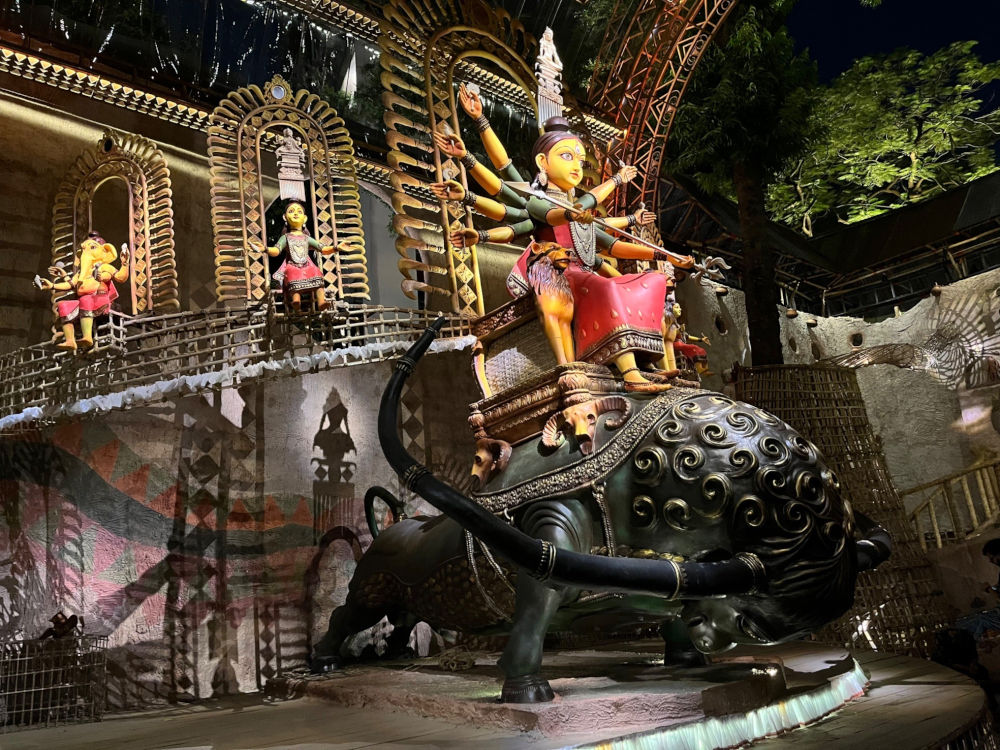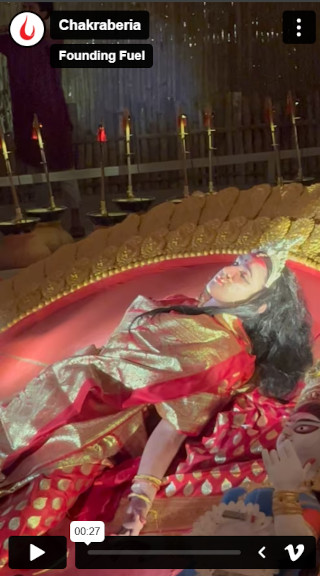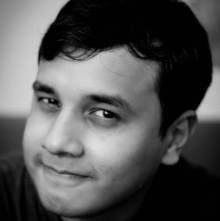A dramatic Mahisasur in Hindustan Park
The time has come again where Bengalis gain more weight, even though we walk more than in the rest of the year combined. Durga Puja has come and gone. And it was a roller coaster. We got a fair bunch of political commentary this year, with one pandal covering the Bengal famine, an Italian conflict and the Gaza conflict in the same brush. We had several pandals celebrating Bengali as a language and script (a result of a comment from those in Delhi that Bengali should be dropped as an official language). We also got some spine symbology, which if you read last year’s article you would see was a response to the RG Kar case.
This year’s pandals were subdued compared to last year’s. There could be many reasons: Sponsors had pulled out at the last minute in 2024. Since those pandals had already made commitments, it ate into this year’s budgets. And then there was rain. We knew this Puja would be rainy, and rainproofing eats up the budget without adding beauty—we have yet to invent an artistic tarpaulin. In fact, this year we got a fully rained out Tritya (the third day) and more rain damage and flooding than we got even in cyclone Amphan in the Kolkata area. (Cyclone Amphan had a wider spread.) But the pumps de-flooded the pandals, and repairs were done double quick—nothing can keep a Bengali from their divine duty towards Durga Puja, not even an act of God.
Interestingly, as a result of commendable work done by MassArt, 24 pandals opened on September 18, a full three days before Mahalaya (which marks the start of the festival). Their rigour and fantastic reputation ensured that these pandals were the cream of the crop. The venerable and sought after artist, Susanta Paul, also opened his pandals three days before Mahalaya, accessible at a fee. If you managed to catch these, you’d very likely have seen the best that Durga Puja had to offer this year, and without getting a drop of some portly Bengali’s sweat on you. So, word to the potential tourist of next year, get MassArt’s pass and come before Mahalaya.
Conversely, the going became very hard between Panchami and Nabami, the fifth and ninth day. Rain concentrated crowds. And the Instagrammers who had access to the early openings ensured that the hapless multitudes swarmed in concentration to particular pandals. But if you stayed dry and at home, or were in the wrong city, not to worry, this intrepid reporter visited over 120 pandals to rank and sort them, so that you don’t have to. (It’s a family tradition. For over 20 years, we’ve faithfully visited nearly 200 pandals each Puja season. And since 2022, I’ve also been cataloguing my shortlist for Founding Fuel.)
The pratimas (idols) this year were particularly stunning. This is a result of two factors: (1) many award institutions give a separate award to pratimas and (2) the Bengal government has started putting the best pratimas in a museum. It allows a much smaller pratima to be immersed (as ritual dictates). This is all in service of the betterment of the form, and an advancement from the pudgy-faced stock pratimas we got in previous years.
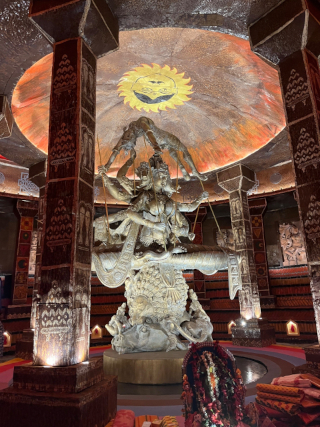
A pratima that is sculpted and viewable from all angles at Netaji Jatiya Sebadal. The smaller pratima in front would be immersed
Additionally, lower overall budgets meant that some previously unknown and smaller pandals shone. (From previous years, I know that what Kolkata does in Rs 20 lakh, Mumbai cannot do in a crore.) Thus the formerly unexplored Netaji Jatiya Sebadal had the best pratima (pictured above)—gotta love a pratima that’s photogenic in full 360-degrees. Also new on the scene was Shyama Pally Shyama Sangha—they captured my heart by linking Eklavya’s story from the Mahabharata with caste (I had no idea), and made me realize that caste, one of India’s top issues, has never been used as a primary theme in the thousands of pandals I’ve visited to date.
This year also saw the rise of the performer. The first time we saw a human integrated into the pandal was a few years ago—a man stamping papers, a repeated dreary movement. In a sense, like Chris Burden, he was part of the exhibition, a live person replacing an artwork statue. Two years ago, this graduated to performers enacting characters from Sukumar Ray’s seminal children’s satire Abol Tabol. And last year Bahurupiya performers were brought in as live statues as well as a play at the centre of it all. This year we saw live performers (or human props) on over-drive. Some of it was tactless; I strongly disliked seeing dwarves brought in as circus clowns, who confined themselves to smiling and waving, or acid-burn victims brought in to add a sense of horror to a pandal on acid burns. Yet others brought in Theyyam dancers from Kerala, whirling dreadlocked ash-smeared Shaivites, and fictional characters brought to life. In some cases I missed the performance, so it’s difficult to judge. Often, it lowered the appeal as the parts written for the performers were insipid and at the level of a school production.
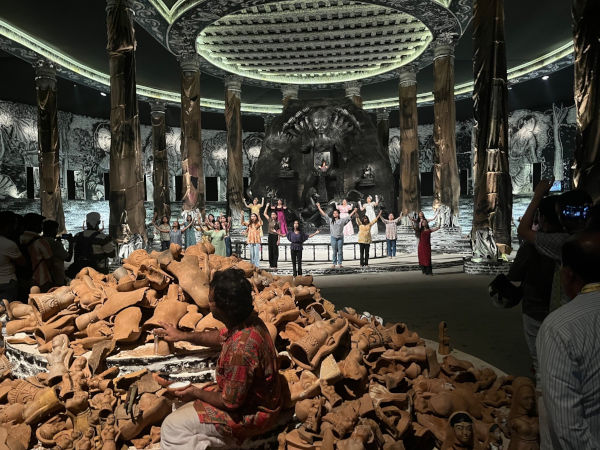
One performer glues together a sisyphean heap of smashed figurines, while the women of the para (neighbourhood) stage a play behind him; the live performers at Dakshindari Youths
Lastly, I need to mention that our method as a family is to assign scores. This year, a whopping 37 pandals scored so similarly (between 7 and 8 on 10) that the second tier list is simply too close to call. In previous years, I think the lists I made were quite defensible, but this time I suspect many will be upset that their favourite pandal was dropped. Also, though there was no shining beacon at the top, the overall quality of pandals has really risen from previous years.
Enough preamble, let’s get to it.
10. Dum Dum Tarun Sangha
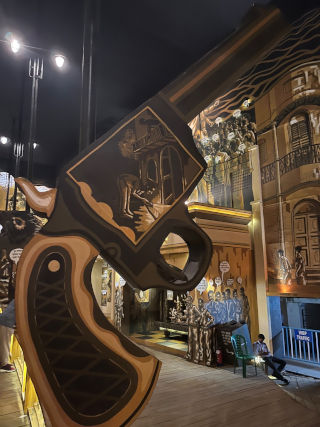
Searching for clues by torchlight, in the barrel of a gun, at Dum Dum Tarun Dal
Inching up from the rest of the crowded tier is Dum Dum Tarun Sangha. Celebrating the stories of Byomkesh Bakshi, we were taken through MassArt’s guided tour by two characters from his books, Ajit Bandhyopadhyay (his Dr Watson) and Satyabati Bakshi (Byomkesh’s beau and later wife). Unfortunately, I’m not well versed with his stories, but the pandal makers certainly knew the content (both source material and films) extremely well. The pandal is surrounded by buildings rendered in comic-style, replete with speech bubbles, representing each book. We pass the pratima, where (shock and horror) someone has stolen her expensive necklace. However will we be able to uncover this mystery? Our attention is turned to a large book (it’s around 20 feet high and has been submitted to Guinness Records as the largest pop-up book). Here, scene by scene the mystery unfolds itself, until on the last page the perpetrator whisks by on a bicycle escaping through the pages of the book into a secret exit of the pandal. Though the mystery is solved, Byomkesh will have to be beckoned to apprehend the fiend.
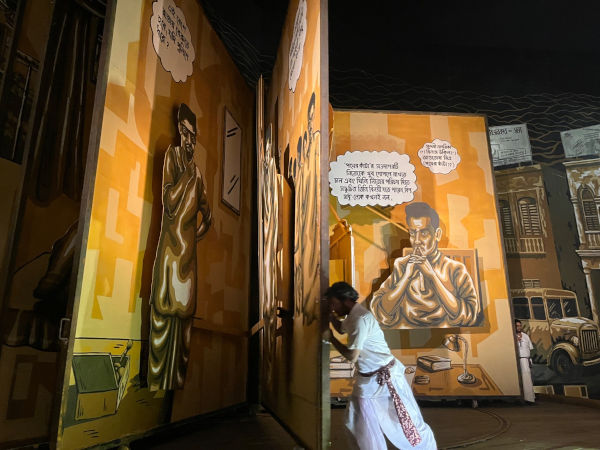
I’ve estimated the height of this pop-up book by judging the height of the gentleman on the right
By the way, the artist, Anirban Das, has done around six pandals this year, many of which are quite good. The pandal has a single-minded, light-hearted vision, and leans fully into it. The art, though not museum worthy, is consistent, and humourous. Everyone is certainly having fun, and for that (and a little bit because I wanted to write about it), Dum Dum Tarun Sangha gets number 10 on our list.
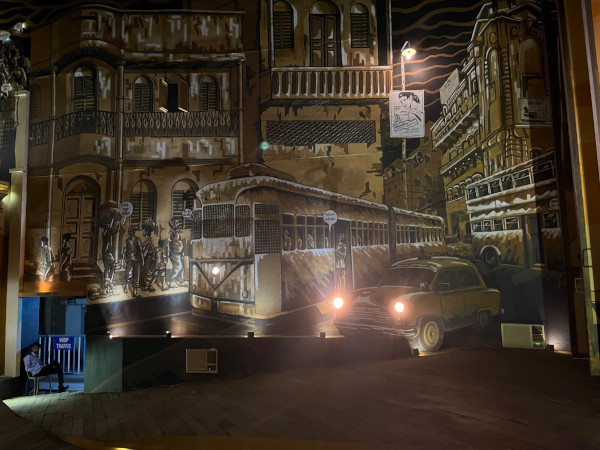
Ah the yellow tram and taxi, just to make us feel more Kolkata
9. Chaltabagan Sarbojonin
One of several this year that celebrates the Bengali language, Chaltabagan’s pandal is steeped in research. We learn the linguistic chronicle of the language’s development, the pioneers in its usage, and a play from a balcony tells us its importance. We learn of a revolt in 1952 in erstwhile East Pakistan, where people protested to make Bengali an official language, and were brutally suppressed. The day of this protest, February 21, is now marked by UNESCO as International Mother Language Day to promote the importance of keeping alive indigenous languages and to commemorate the rare instance in history where people were martyred in defence of their mother tongue. And finally, we learn of the New York Ballot, where Bengali became the fifth official language—after English, Spanish, Chinese and Korean—for the US presidential elections.
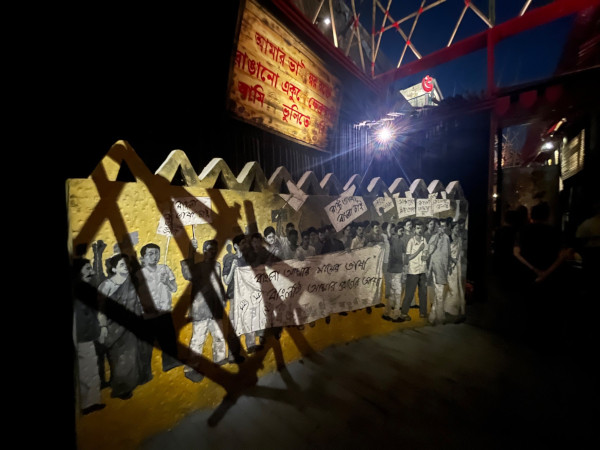
The Bangladeshi language revolt of 1952; the caption reads ‘Bengali is our mother tongue, Bengali is our every hope’.
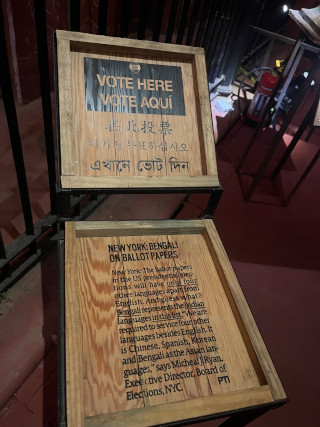
Vote in Bengali at the NYC ballot for the 2025 presidential elections
Yes, of course, Chaltabagan is engaging in a political debate, but it chooses to do so with care, delicacy and profundity. A lot was lost on me, which includes the argument on why Bengali is one of the softest, most pleasant languages. (A German friend used to call it the ‘Bubble language” because when I spoke Bengali, it sounded to her like I was blowing bubbles.) In any case, I believe in ‘show don’t tell’, so if you show me the respect and depth of the history of a language, rather than just telling me to ‘respect the history of the language’, I’m certainly more engaged. Mind you, they do this without shortcuts (they recognise that written Bengali script is fairly recent, on a historical scale). For its beauty, tenderness, and the consistent artwork by artist Pradipta Karmakar with a narrative thoroughfare, Chaltbagan makes it to this list.
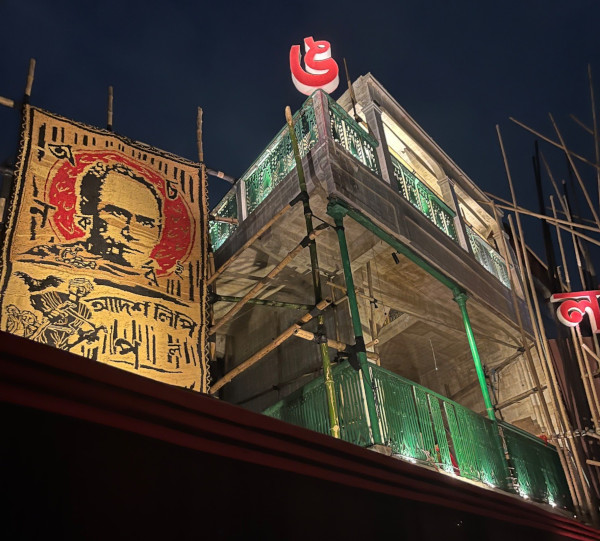
Woven artwork of Ishwar Chandra Vidyasagar upon an actual bungalow in Chaltabagan
8. Hatibagan Nalin Sarkar Street
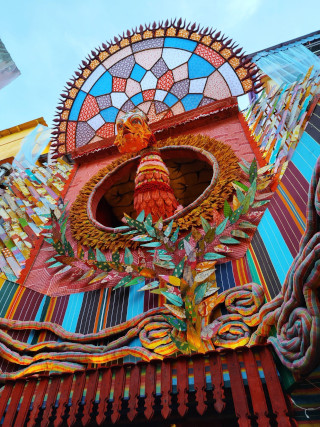
A three faced beast guards the entry to the pandal. But the fellow has only four eyes between them. Once inside, you see that he’s actually a boat and his limbs are oars
The artist, Sanatan Dinda, crops up again and again for the last 10 years, if I remember correctly, and often his pratimas leave a lasting impression on my mind. This year the pratima is no different, with a swirling mass of limbs— over 10 arms and several pairs of feet. While the pratima is reminiscent of the fantasy animation of Tom Moore, the rest of the imaginary beings that overrun the pandal are similar to the imagination of Japanese animator Hayao Miyazaki.
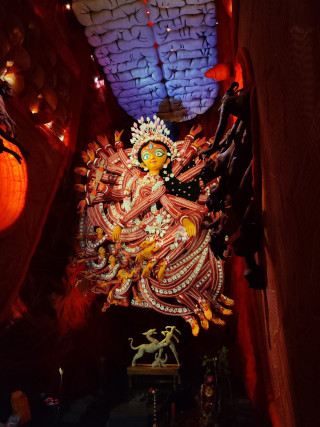
An overjoyed Durga, tangled in her own limbs
The pandal itself is lined by actual buildings down this narrow street. The artist makes full use of this, and the kind cooperation of the residents, to make his creatures spring from every available rooftop and balcony. I, unfortunately, went during the early morning, so I embed here the video of a random stranger on the internet, and hope that he doesn’t mind. Excuse the noise of the thronging crowd.
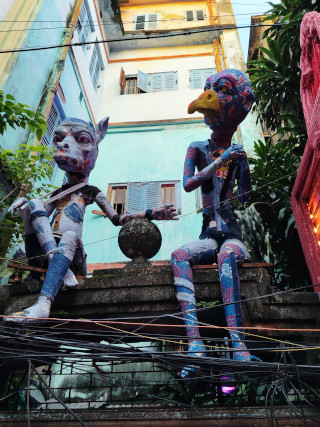
Can’t blame him for being grumpy, it is very early to be up
Mechanised art brings the beings to life. If Bengal had a feywild, this would be it. I give it such high marks because true art breaks paths, and even though I have referenced other artists in my description, the creatures are consistent, in form, mood and style, and are not entirely like anything seen before. It takes a very particular mind to be able to create that, and an even more steady hand to guide its execution without some part of it being rendered wayward (especially if you have nothing to draw from as a reference to show the executors).
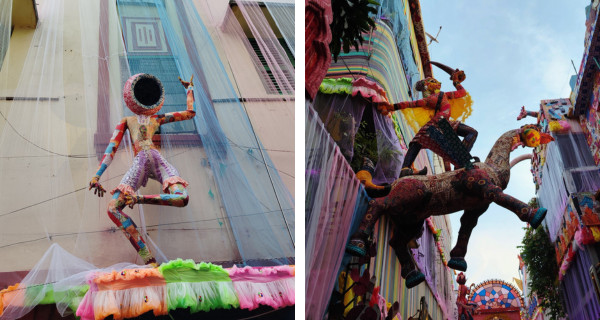
L to R: One of the strange creatures that hangs out by the wall of one of the buildings that make up the sides of the pandal; Nothing screams adventure like a swordswoman on a chicken horse
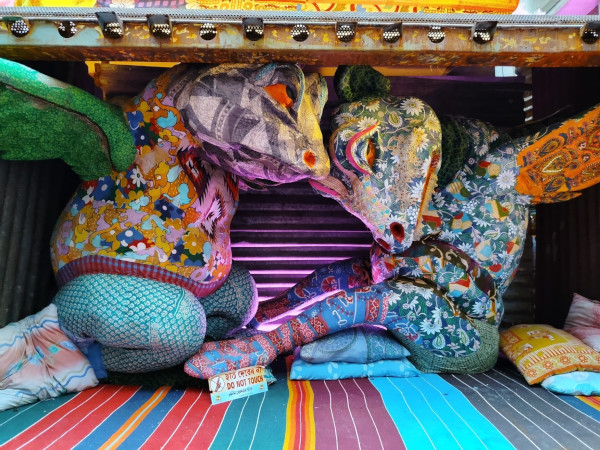
It’s probably time to sleep for us too
7. Alipore Sarbojonin
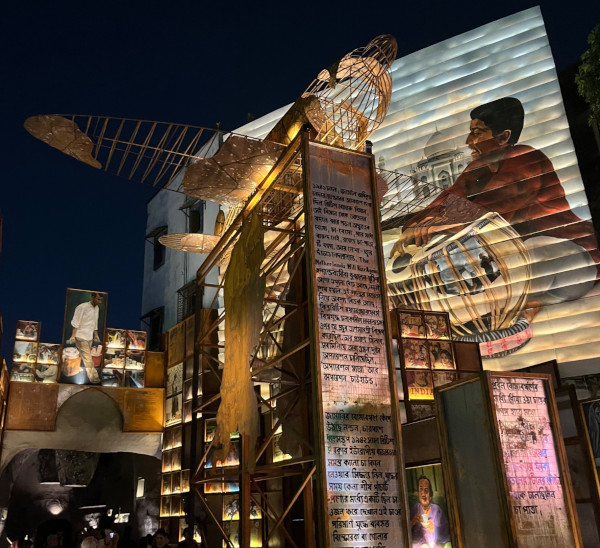
The entrance, the drama and ‘wah Taj’ at Alipore Sarbojonin as conceptualised by Pradeep Das
At first you are greeted overhead with a wooden propeller plane, and alongside are paintings of British women at tea time. Behind the plane is a painting of Zakir Hussain (all will become clear soon). As you go further in, a statue of a woman (presumably Assamese) with a basket on her back. Around you is a Tibetan temple, adorned with Chinese paintings. Alipore Sarbojonin is a meditation on tea, and a salute to the heritage of it.
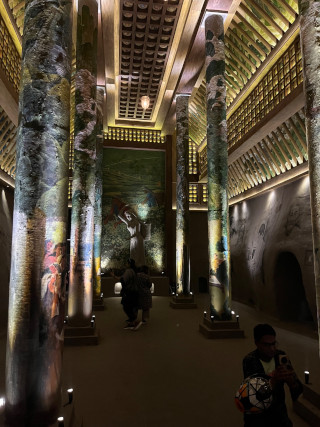
An orientalist temple deifies the tea picker in a corner
Vaulting pillars and tiny paintings on the roof make it grand, but also detailed, with a very consistent artwork. The artwork is South-East Asian/Tibetan and Hindu deities are rendered in their distinct style. Durga is styled like a Buddhist Apsara, with two Buddhist paintings on either side. Tea came from China, it says, and was introduced to us by the British. Fun fact: our beloved drink wasn’t drunk by Indians until the last 100 years.
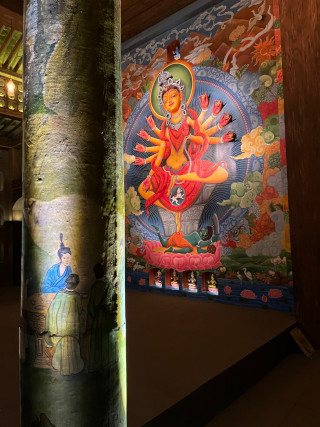
A Tibetan Durga pratima in the background with a Chinese pillar in the foreground
In the same breath, I should mention Dum Dum Tarun Dal, which had an almost sisterly meditation on stamps, woodcuts and all things that are pressed down to make an impression (chaap). I wanted to pick only one among the two, as they are quite similar in approach. Though Tarun Dal has an impressive pratima and more research, the consistency of the art style led to Alipore Sarbojonin winning out.
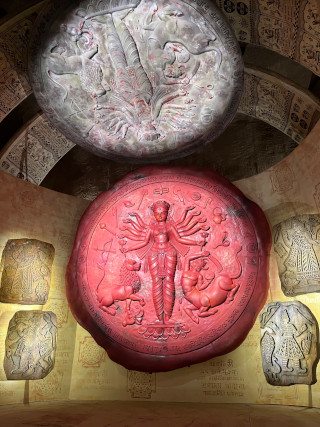
The pratima set as a seal in Dum Dum Tarun Dal
6. Pratapaditya Tricone Park
You’ve probably heard of Raja Ravi Varma, but if you haven’t, you’ve probably seen his work on calendars and matchboxes. Think of an image of a Hindu God or Goddess. That would probably be painted by him. Pratapaditya Tricone Park takes us into his work and his house. Tidbits of history abound.
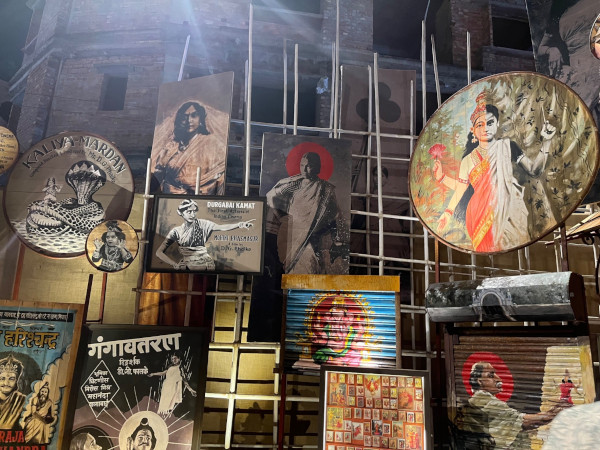
Raja Ravi Varma: I suppose the closest thing we have to an Indian art pop icon
The pandal starts with a collection of his work, prints, matchboxes, shutters and film posters he must have done. It’s challenging to make this coherent and not a messy assemblage, especially considering our brains usually associate his work with oversaturated posters on the back of the oldest shop we know. Once you pass this you come upon the small inner courtyard, where you’re greeted with a projection of his drawing coming to life. It’s clever to make this courtyard feel miniaturised, because next you walk into a house and a massive living room, where diagonally placed, taking up a full 3/4ths and drama-ready, is the Durga pratima. I don’t think she’s done in Raja Ravi Varma’s style, but her children are, and contrasted against them the pratima looks several times as fierce. There’s also something about this room that makes it look much more massive than it seems from the outside. It’s one of the first pandals where I feel they must have made a 3D mockup and placed objects, because it’s cleverly done to give an illusion of grandeur in what is effectively some Bengali home.
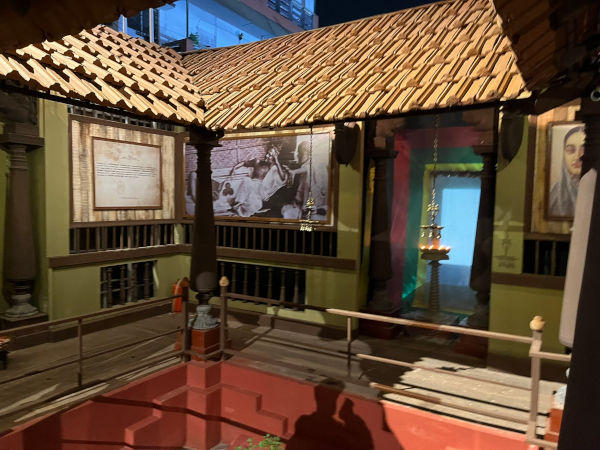
The courtyard, adorned with paintings, behind which you see a projection of a sketch being done
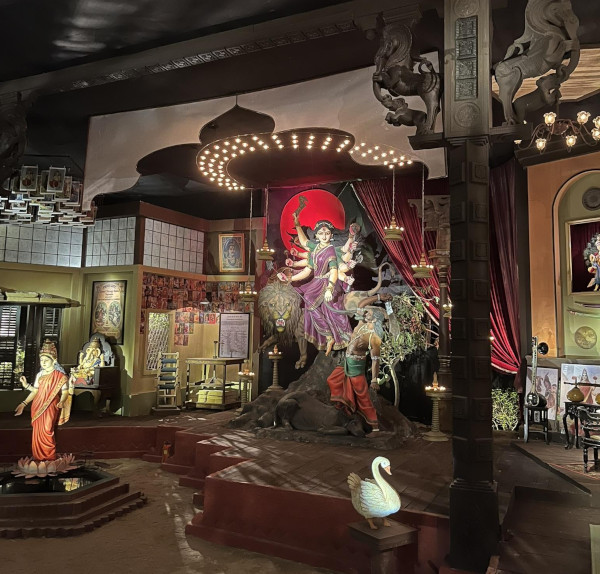
If only I had space for that in my living room
The creators are Deep Das and Eshika Chandra. Somehow my own photos don’t really give you a sense of the space, so I’ve enclosed a video from the Pandal makers.
5. Belighata 33 Palli
If you weren’t feeling Bengali enough, the next on our list is a commentary on consumer culture, and thus of course, capitalism. This comes to us from artist Shib Shankar Das. Outside the pandal, stacks of brimming shopping carts overflow with bills that waterfall and twist several hundred feet. To the right are sacks and sacks of grain, but if you zoom out, you realise it’s stacked to look like a maize stalk. Step in and the arm of a back-hoe loader is cavorting about in an error state. Opposite it a grain mill rotates. The machine, making the whole system move, appears to operate an intricate printing press, but actually it prints a long bill.
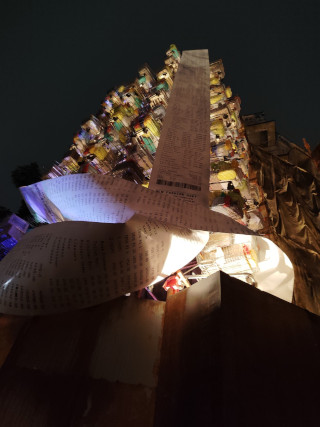
I guess I’m going to have to pay by card
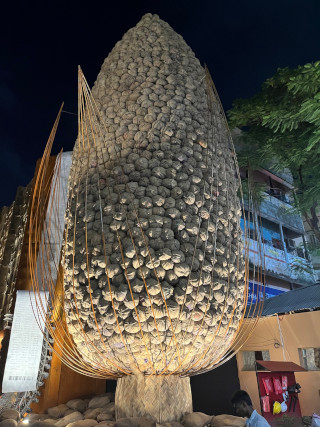
Gunny bags are the corn nubs of a giant ear of maize
As we enter further, the gunny sacks turn colourful, wrapping in large letters, a common Bengali phrase—a mother’s plea to give her child a sustainable life. But above, paintings of storming hordes, have a placard that reads “Roti, Kapda, Makaan & Data”.
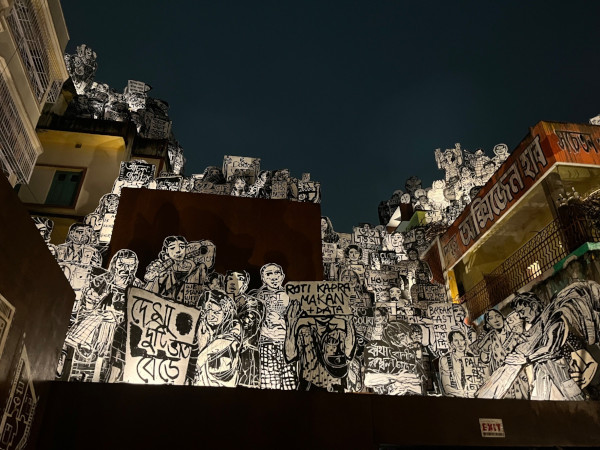
For all their shopping, they don’t look too happy
But as the faces of capitalism clamour forth among the vertical banners of bills that drape the buildings, Ma Durga herself has an austere visage. She looks like a rough pencil sketch rendered in metal. Simplicity, she seems to say, and this is how she chooses to combat the Asura that consumes us all in these fouled times.
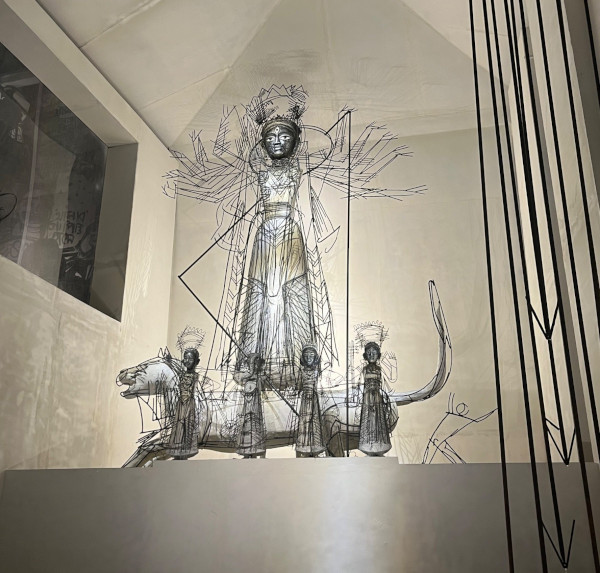
Durga and her children in an expressionless sketch. The Mahisasur is perhaps consumerism itself, or perhaps opulence that she stands against, or maybe it’s the frightened stick-figure in the lower right corner
4. Kendua Shanti Sangha & Dum Dum Bharat Chakra
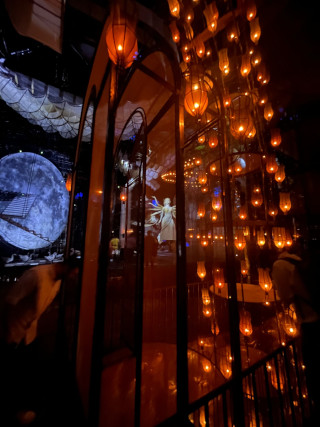
Transparent archways allow us a glimpse of Durga
Then we have the tour de force of Susanta Paul. He has three pandals this year, two of which would have made the top 10, thus crowding out the other contestants. In order to be fair (I am nothing if not a partial judge), I’ve condensed both of these in one spot, to give breathing room to the others.
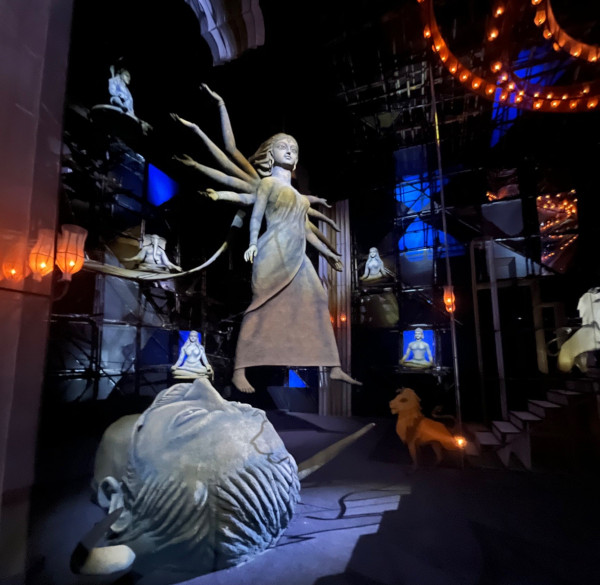
Low lighting allows the pratima to be suspended without any visible means. Meanwhile the severed head of Mahishasur lays vanquished before her.
With a signature style of dimmed pin pricks of light, metalwork and boomingly hypnotic soundscapes, Susanta Paul has perfected the art of setting the mood. The pandal is mammoth, impressive, serene and you, a humble passenger in her waters. Wrought iron lamps guide you through. In Kendua Shanti Sangha, you get his archways and stairs that lead nowhere (or perhaps they lead to another dimension). The pratima floats, suspended by unseen structures, levitating past the head of a newly felled Mahisasur.
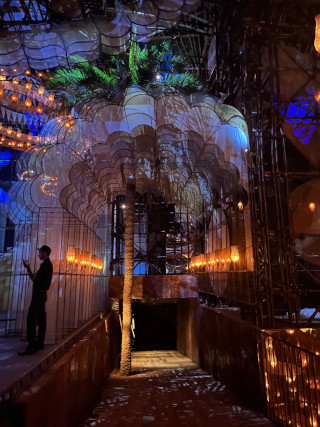
While we’re agog with wonder, the guard at the exit gate scrolls on his phone.
At Dum Dum Bharat Chakra his focus is single-minded peacefulness, LED strips halo the entranceway, as projections on swiftly rotating fans make the projected image appear to float in our consciousness rather than be tethered to any actual mundane reality. Durga, having felled her foe, and being the deity she always is, contemplates existence so deeply that she is backlit by the aura of celestial tranquility.
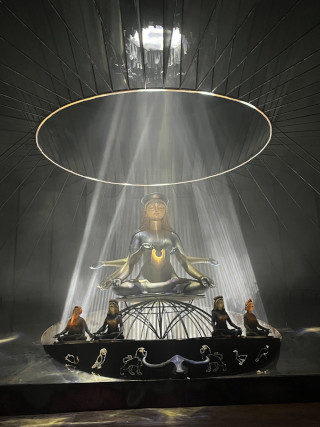
While her arms are currently supplicating, later the flower malas are placed on Durga’s hands, as opposed to around her neck, which almost makes her look like she’s offering it to you
The terrible debate is should one give Susanta Paul highest credit year after year. On the one hand, any new tourist should visit, and it may well be their favourite. On the other hand, it’s same old, same old and we’ve seen his work vault to more majestic heights in previous years. Maybe one should consider him like Van Gogh, an artist who is instantly recognisable and untouchable in his very particular style. But perhaps we should ask more of him every year, because we, the greedy consumers of art, have whims that must be catered to.
Incidentally he has diverted from his normal style in his brightly lit Ballygunge Cultural. I’m not sure if it’s the budget of the place, but that pandal did not hit the sweet spot. It probably wouldn’t have made the top ten list in any year. Thus is the fickleness of us culture vultures—if we get what we want, we don’t want it any more.
3. Chakraberia
I doubt Chakraberia would make it to many top tens this year. The artsmanship is untidy and purposely leaves a lot of unfinished bits and untidy loose ends (an art style, which while prevalent in many artists in Kolkata, is never seen in the art galleries of Delhi or Mumbai). The theme, by artist Rintu Das, is injustice against women, honour killings and forced marriage with the subsequent oppression of a soul that never again sees freedom. It’s an old theme, we’ve seen it magnificently deployed before. But this pandal has one trick that makes it haunt.
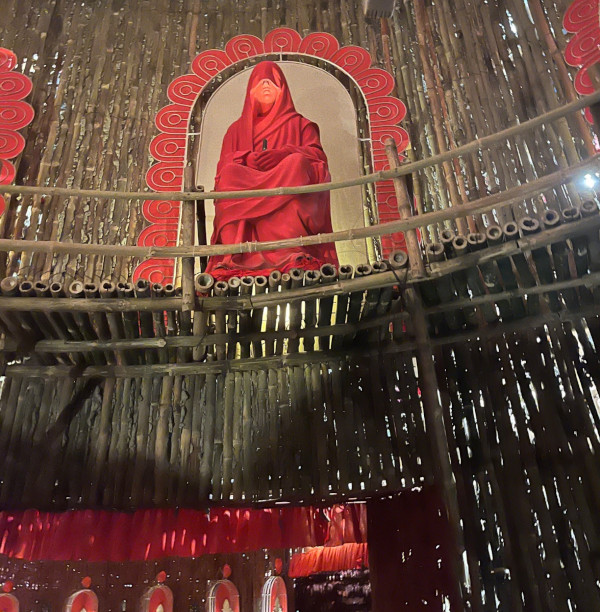
Does she sit in judgement or is she a silent watcher, or was she oppressed and regime indoctrinated, a symbol of the terrors to come?
As you enter, lights and microphones swirl above. Women dressed in red sarees, heads covered, sit in judgement, reminiscent of Margaret Atwood’s Handmaidens. Below, triggering suddenly and without warning, are impatient feet smashing something. It’s the Bengali ritual of bodhu boron, where a bride is meant to step on alta and milk. But the alta looks like a blood splatter and the feet sound like they’re throwing a mini tantrum. It stops as suddenly as it starts, and then suddenly it sweeps like a Mexican Wave around the pandal till we drown in it.
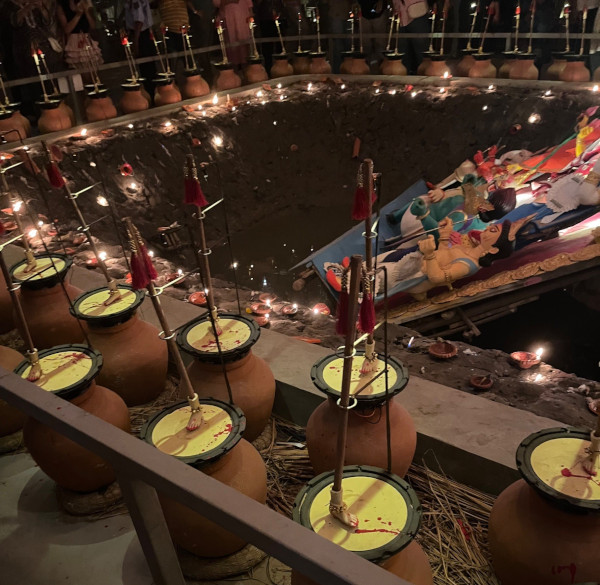
A chorus of indignancy, mechanised feet symbolising the 'bodhu boron' bridal ritual
At the centre is a lopsided Durga being immersed. The art really isn’t the best, it feels like a Madam Tussaud’s wax figure stuck crooked on a very inexpensive frame surrounded by cheap clay figures of her children. Startlingly, the eye of this figure opens in terror. It looks left and right, as if gasping, a mute cry to tell us she’s still alive. A finger twitches. The eyes, as if struggling under anaesthetic, close again.
Gosh, it takes you by surprise. Yes, it’s animatronic, but for a moment, I thought it was a real woman, being sacrificed. It’s also amazing how expressive it is, despite really being just a wax doll. The suddenness of it all stays with you. I am terrible at capturing the actual moment, but my attempt is below.
Trying to catch the moment in video, of the figure awakening. Watch the clip here.
Inside, the pratima is indignant. Unlike other pratimas who have vanquished their foe, or express the spoils of victory, this pratima is unsheathing her sword. There is work yet to be done, this idol says, and why are you not as filled with wrath as I?
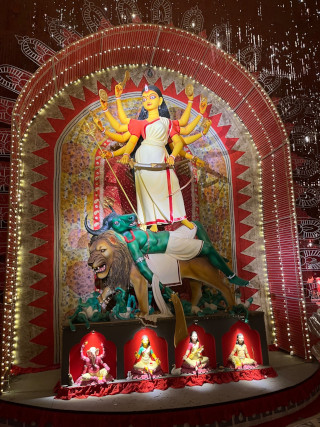
The avenging mother protector at Chakraberia
2. Tala Borowari
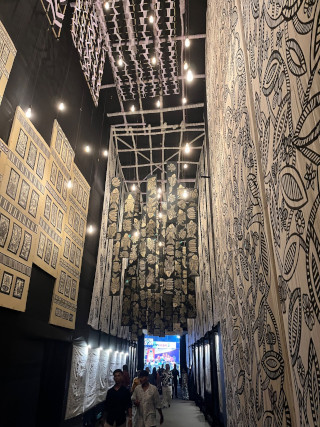
A reverse shot of the black and white entry way to Tala Barowari
Deep breath now, the small lanes that lead up to Tala Borowari have you walking a fair distance. You’re greeted by marvelous Madhubani in black and white. At first it towers overhead as it funnels the tired throngs into a narrow passage. Suddenly you turn a corner and are greeted with the most multicoloured multitudes of Madhubani art you could imagine.
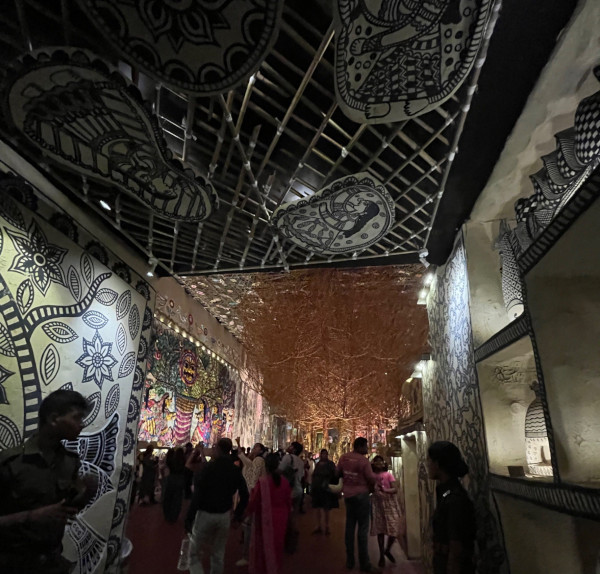
Opening up to a scale and splendour
It’s interesting how that little turn into grandeur has an instantly audible effect on the crowds who have walked with me. Black and white turning into colour is also a master stroke. Some of the art is gigantic. On my left is an artwork overlaid by a metal outline about a foot in front of it. On two sides tied to the bamboo structure are charpoys facing all directions except right side up. In the centre is an ornate and stylised forest of trees wrapped and re-wrapped in coloured cloth.
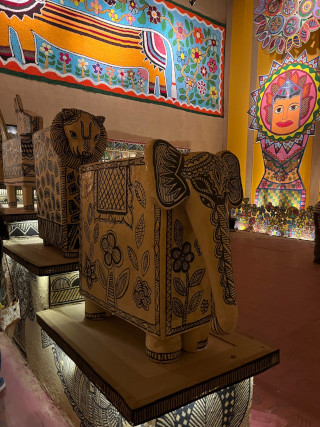
One has to love Madhubani animals
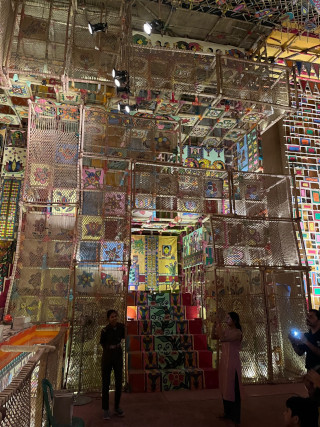
Who would’ve thought charpoys could be so immersive?
The pictures don’t do justice to how sensorially overwhelming it is. Just like some sarees look too much in photographs but look so opulent in person, if you have many colours and many images, one focuses on each one when you are there in person, but as a photograph it becomes less natural to do so.
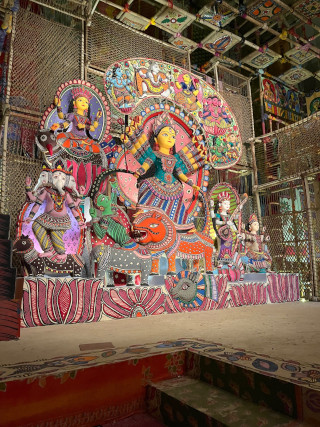
Durga pulls Mahisasur’s hair with one hand, and her lion’s tail with the other
I also feel that this pandal is an excellent example of how Kolkata seems to know exactly what it’s doing when it needs to stretch the budget to look so much more than the amount spent to create it. A salute to artist Prastana Paul, execution is a large part of the form.
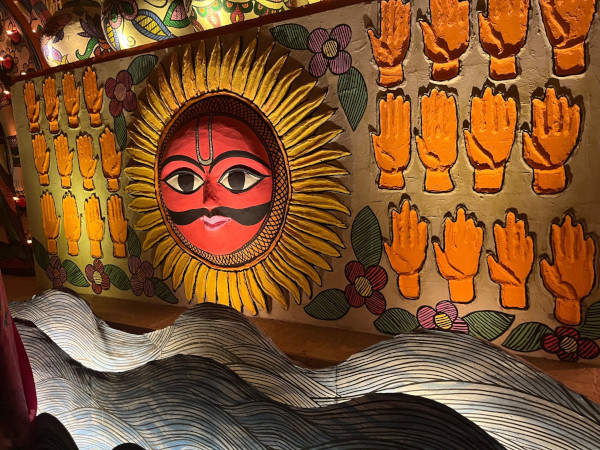
Smile and wave!
1. Purbachal Sankti Sangha
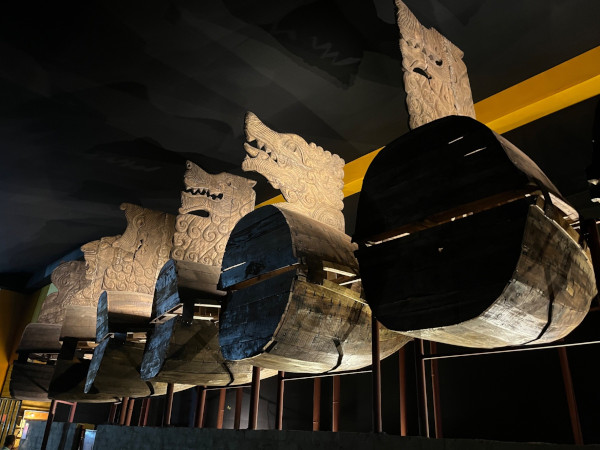
Wooden guardians greet us at our entrance
Let’s face it, the reason Purbachal Sankti Sangha looks and feels like a high-profile curated art gallery is because, for all intents and purposes, it is the kind of a high-profile curated art gallery that (surprise surprise) I swoon for. It honours woodcut work, etches, prints and sculptures and specifically honours the master in the woodwork space, Bengali artist Haren Das.
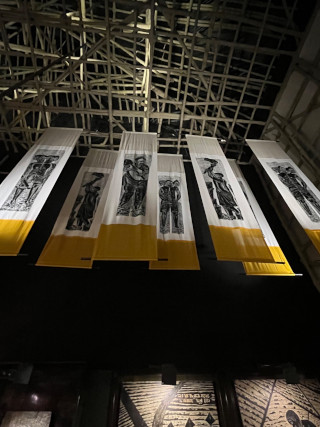
Scaffolded high above us are woodprints several metres tall
The trouble with judging something like this is that the artwork is resplendent. Of course, many pieces are from Haren Das himself, who was doubtlessly skilled. Therefore how much credit goes to the people curating his work and like-minded work from similar artists, versus others who are making the artwork of pandals from scratch?
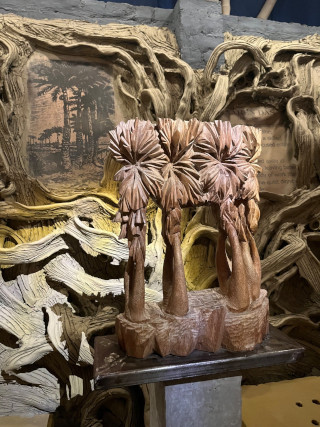
A wooden sculpture against the clay backdrop
Then again, there is a craft behind creating the space. There is a section behind a metal gate that we can only peer through. It was created, but to think of creating a space out of bounds is a curious addition. (By the way, the tree that grows there abruptly makes one aware that one is not inside an airconditioned building.) There is a space for sitting and reflecting (which I’ve never seen in any pandal before). And there’s a spot that informs us that we can touch the artwork, very much reminiscent of modern museums. Very sweetly, there’s a corner that lists the entry log of every person who worked on the pandal as well as a scattering of photos of the construction.
Ironically, the pratima itself is not fantabulous. I suppose she is being created in a particular style, and I do like Shiv as the moon marked overhead through a small gobo light. She is set against roots made of clay that form the backdrop of many parts of this museum.
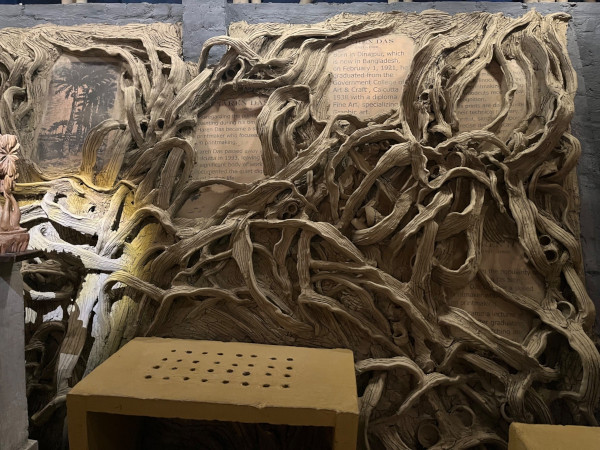
A seating space, which has explanatory text behind clay sculptures of wood branches
Watch a video from their channel, which would perhaps capture the walkthrough better than I.
Conclusion
This was a year where there wasn’t any pandal that stood high above the rest. In that sense, one can argue that it is muted. But the quality of the second tier is really remarkable. There is no doubt that the average artistic quality of the city rises year on year. Just so that you can have a gander of the art that you missed out on, I close this article with a few images of pandals that didn’t make the cut. And I hope to see you again next year, though I’d rather you come and see it in person, than have to read about it here.
